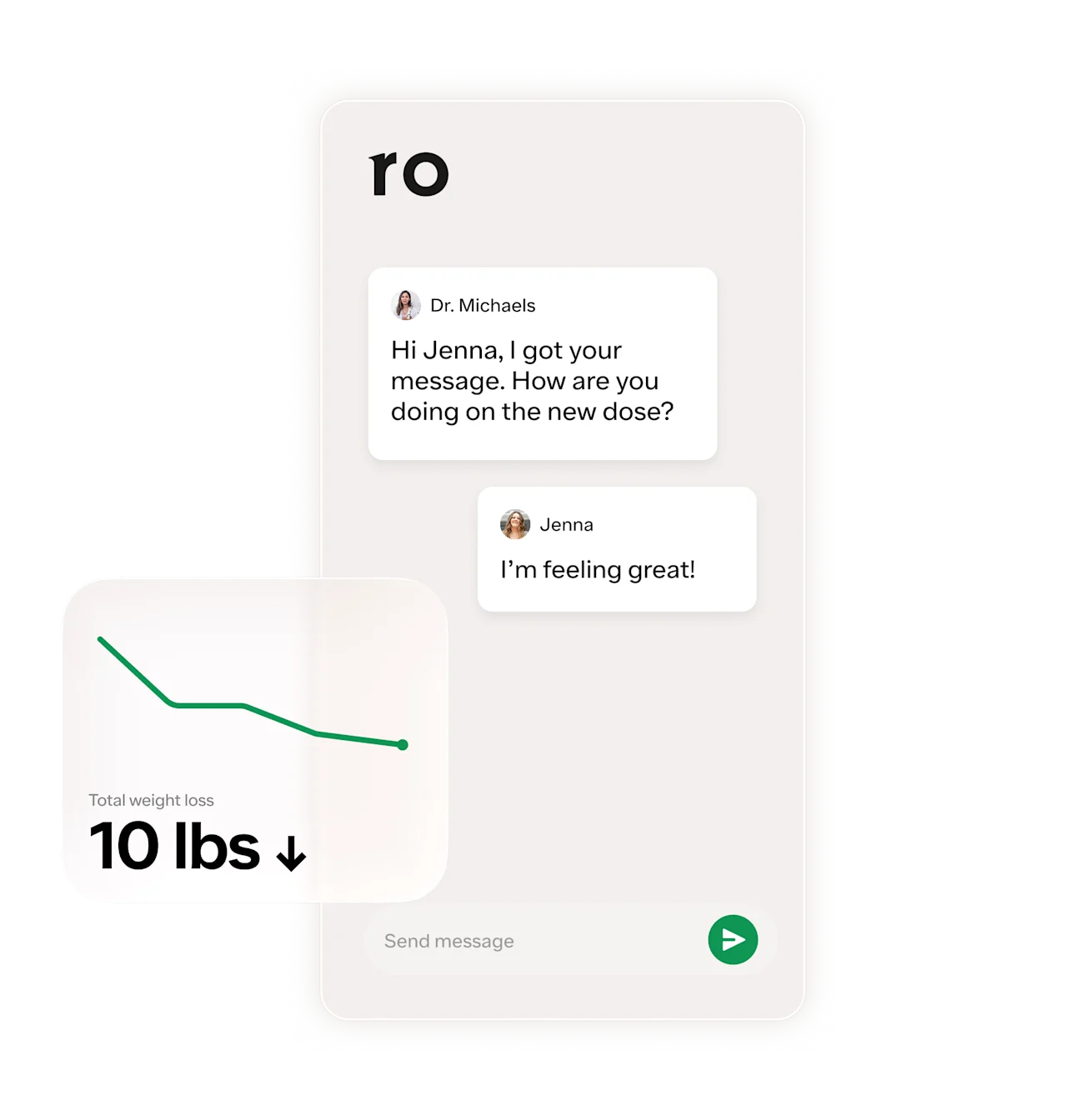Key takeaways
Orforglipron is an oral GLP-1 pill in late-stage trials that may offer weight loss and blood sugar benefits similar to GLP-1 injections like semaglutide (Wegovy) .
Clinical trials show up to about 15% average weight loss after 36 weeks and improved A1C in adults with obesity or type 2 diabetes who took the drug.
At the time of writing, Orforglipron is not FDA-approved yet, but it may become available in 2026.
Here's what we'll cover
Here's what we'll cover
Here's what we'll cover
Key takeaways
Orforglipron is an oral GLP-1 pill in late-stage trials that may offer weight loss and blood sugar benefits similar to GLP-1 injections like semaglutide (Wegovy) .
Clinical trials show up to about 15% average weight loss after 36 weeks and improved A1C in adults with obesity or type 2 diabetes who took the drug.
At the time of writing, Orforglipron is not FDA-approved yet, but it may become available in 2026.
Weight loss medications are a-plenty. But weight loss pills that offer benefits similar to injectable GLP-1 drugs? They may be hitting the market soon, with one promising option called orforglipron (pronounced or-FOR-glip-ron).
Orforglipron is an oral GLP-1 medication for weight loss and diabetes that’s in the final stages of development by Eli Lilly. (Yes, the same company that makes slim-down superstar, Zepbound.) While it’s not yet approved by the US Food and Drug Administration (FDA), the pill may be soon enough.
So, there’s no better time than the present to get to know orforglipron, how it works, its potential side effects, and more.
What is orforglipron?
Orforglipron is a new oral medication for weight loss and type 2 diabetes that’s being developed by Eli Lilly.
Key details to know about this next-gen GLP-1 receptor agonist:
It’s a once-daily pill that doesn’t require any fasting. The current GLP-1 pill option, oral semaglutide or Rybelsus, must be taken on an empty stomach with a small amount of water, followed by a 30-minute wait before any other pills, food, or drinks. (FYI, Rybelsus is approved for type 2 diabetes, not weight loss.)
Orforglipron is not a peptide. Most GLP-1 medications are peptides that are easily damaged by digestive enzymes and poorly absorbed in the gut. As such, the injection route works better for current GLP-1 drugs. Orforglipron is a non-peptide. Its molecular structure allows it to stay more stable and better absorbed through the gut.
Results from Lilly’s studies have shown that orforglipron can lead to major improvements in both blood sugar and weight. Research thus far has been done in adults with type 2 diabetes whose blood sugar remains high despite lifestyle changes and adults with obesity or overweight who do not have diabetes.
The brand name isn’t known yet. If approved by the FDA, Lilly will announce the brand name (which hopefully will be easier to say and spell!) and dosage details. It may also have separate versions for diabetes vs. weight loss, similar to semaglutide (Ozempic vs. Wegovy).
Hear from Ro patients
Ro members taking branded GLP-1 medications were paid for their testimonials.
How does orforglipron work?
The orforglipron pill generally works the same way as other GLP-1 medications, such as semaglutide. These drugs mimic a natural gut hormone called glucagon-like peptide-1 (GLP-1) to help regulate blood sugar levels, digestion, and appetite.
When orforglipron attaches to GLP-1 receptors, it:
Increases insulin secretion to keep blood sugar steady.
Slows stomach emptying so food stays in your stomach longer, helping you feel full sooner and longer after eating.
Reduces appetite so you feel less hungry and consume fewer calories to support weight loss.
Research on orforglipron
Clinical studies suggest that orforglipron can significantly improve both weight loss and blood sugar control in adults with obesity or type 2 diabetes.
Weight loss:
In a phase 2 clinical trial, adults with overweight or obesity lost an average of 9.4%--14.7% of their starting weight after 36 weeks of taking orforglipron. Those who took a placebo lost just 2.3% of their body weight.
In a phase 3 ATTAIN-1 trial, adults who took orforglipron for 72 weeks lost an average of 7.5%--11.2%. The placebo group had merely a 2% average weight loss.
Type 2 diabetes:
In the phase 3 ACHIEVE-1 trial, adults with “early” type 2 diabetes who took orforglipron experienced a drop in their A1C from 8% to 6.5%–6.7% after 40 weeks. (FYI, participants were not on any other diabetes medications at the start of the trial.)
Participants also had an average weight loss of 4.5%–7.6% over the same period, with those who took higher doses experiencing the higher end of the range of weight loss.
Orforglipron side effects
Common orforglipron side effects reported in trials are similar to other GLP-1 drugs and mainly affect the digestive system:
Nausea
Constipation
Vomiting
Diarrhea
Burping (eructation)
Indigestion (dyspepsia)
As with other GLP-1s, more serious side effects are possible, such as an inflamed pancreas or low blood sugar (hypoglycemia).
Lilly plans to release additional safety data in early 2026. And once the medication is FDA-approved, there will be more complete information about adverse effects on the drug label.
Interaction information at this point is limited. But it’s likely that other medications or supplements could affect how orforglipron works or may raise the risk of side effects. For example, if you take other diabetes medications — like insulin or pills that lower blood sugar — your healthcare provider may need to adjust your doses if you start orforglipron.
Because orforglipron is still being studied, its official contraindications have not yet been confirmed. However, as with other GLP-1 medications, it will likely not be recommended for people with a personal or family history of thyroid tumors or multiple endocrine neoplasia type 2 (MEN2).
Additionally, there’s not enough data to determine whether orforglipron is safe during pregnancy or breastfeeding. People planning to become pregnant will probably be advised to stop orforglipron several weeks before conception — once official guidance becomes available.
When will orforglipron be available?
Orforglipron may be available sometime in 2026.
Lilly plans to submit its new drug application for orforglipron to the FDA in two phases: first for obesity in late 2025, then for type 2 diabetes sometime in 2026.
Once the FDA accepts a new drug application, the standard review process typically takes up to 10 months. That means, if everything stays on track, orforglipron could be available by mid-to-late 2026.
Orforglipron price: how much will orforglipron cost?
According to Lilly, if (and, hopefully, when) orforglipron is approved by the FDA, self-pay patients with obesity will be able to get orforglipron through LillyDirect starting at $149 for the lowest dose. From there, additional doses of orforglipron can cost up to $399. Remember: Self-pay means that these are cash prices.
We won’t know the official list price of orforglipron until it’s approved by the FDA and Lilly announces a price — that is, again, if it’s approved by the FDA.
Orforglipron vs. semaglutide vs. tirzepatide
So, how does orforglipron compare to other injectable weight loss medications, such as fellow GLP-1s semaglutide (Wegovy) and dual GLP-1/GIP medications like tirzepatide (Zepbound)?
First, quick refresher on orforglipron:
It is not (yet) FDA approved.
It’s an oral GLP-1 receptor agonist in late-stage development for obesity and type 2 diabetes.
It activates GLP-1 receptors to lower blood sugar levels, slow how fast food moves through the digestive system, and curb appetite.
It doesn’t have an official dose or dosage yet, but it was taken once daily in clinical trials.
In comparison:
Semaglutide is a GLP-1 like orforglipron. It’s FDA-approved for weight loss and management as a once-weekly injection (Wegovy) and a once-daily tablet (Wegovy pill).
Tirzepatide is a once-weekly injection that’s FDA-approved for weight loss and chronic weight management under the brand name Zepbound. It’s a dual glucose-dependent insulinotropic polypeptide (GIP) and GLP-1.
How do average weight loss results compare? While real-life experience can vary, here’s what clinical trial results have found:
Orforglipron: Phase 3 obesity trials in people without diabetes show up to 11% weight loss after 72 weeks when taking 36 mg daily (the highest dosage option).
Semaglutide (Wegovy): STEP studies found 15% average weight loss after 68 weeks in adults with obesity or overweight (without diabetes) with a weight-related health condition.
Semaglutide (Wegovy pill): An OASIS 4 phase 3 clinical trial found 13.6% average weight loss after 64 weeks in adults with obesity or overweight (without diabetes) taking 25 mg of oral Wegovy daily.
Tirzepatide (Zepbound): SURMOUNT-1/-2 trials show 15%–22% average weight loss at 72 weeks, depending on dose and whether participants had diabetes.
Keep in mind that the best way to compare medications is a head-to-head clinical trial. That’s because different trial results can vary significantly depending on the participants, the study design, the study duration, and the outcomes measured.
| Orforglipron | Semaglutide | Semaglutide | Tirzepatide |
|---|---|---|---|---|
Brand name | None yet | Wegovy | Wegovy pill
| Zepbound |
What it is | GLP-1 | GLP-1 | GLP-1 | Dual GIP/GLP-1 |
FDA status | Not approved yet | Approved for: Weight loss and long-term weight management in certain people (age 12+) with obesity or overweight Reducing cardiovascular risks in adults with heart disease and obesity or overweight | Approved for: Weight loss and long-term weight management in certain people (age 12+) with obesity or overweight Reducing cardiovascular risks in adults with heart disease and obesity or overweight | Approved for: Weight loss and long-term weight management in adults with obesity or overweight Obstructive sleep apnea in adults with obesity |
Form and frequency | Oral, once daily | Subcutaneous injection, once weekly | Oral, once daily | Subcutaneous injection, once weekly |
Weight loss results (averages in trials) | Up to nearly 12% at 72 weeks in those without diabetes | ~15% avg at 68 weeks in those without diabetes | 13.6% at 64 weeks in those without diabetes | About 15%–22% at 72 weeks (those with diabetes at the lower range and those without diabetes at the higher range) |
Bottom line
Orforglipron is a next-generation oral GLP-1 that could help many people reach and maintain their health goals, particularly in terms of weight and blood sugar. Here’s a recap of what we’ve covered:
Orforglipron is an oral GLP-1 medication made by Eli Lilly that’s still undergoing clinical trials.
It is not (yet) approved by the FDA, so it does not have a brand name at the moment
There’s also no official dosage yet. In studies, people took orforglipron as an oral capsule once daily in the morning.
Research thus far shows strong benefits for weight loss and blood sugar control — similar to injectable GLP-1s, such as semaglutide and tirzepatide.
If all goes well, Lilly plans to submit for FDA approval in late 2025 and early 2026.
Frequently asked questions (FAQs)
Is orforglipron the same as tirzepatide?
No. Orforglipron and tirzepatide are made by the same pharmaceutical company, Eli Lilly, but they’re two different drugs.
Orforglipron is an investigational drug that targets only GLP-1 receptors.
Tirzepatide targets both GLP-1 and GIP receptors and is FDA-approved as Zepbound for weight loss and Mounjaro for type 2 diabetes.
How effective is orforglipron for weight loss?
People taking orforglipron daily for 72 weeks without diabetes mellitus lost about 7.5%–11.2% of their body weight on average in studies. That’s a reduction of 15-22 pounds for someone starting at 200 pounds. By comparison, people without diabetes who took the injectable GLP-1 medication semaglutide (Wegovy) lost about 14.9% of their body weight after 68 weeks of treatment.
Keep in mind, orforglipron is not yet FDA-approved.
What is the difference between orforglipron and semaglutide?
There are several differences between orforglipron and semaglutide — the biggest of which is how they’re taken.
Orforglipron is a once-daily oral capsule that can be taken without fasting or special timing.
It does not require any food or timing restrictions, making it potentially more convenient than other oral GLP-1s.
It is still in clinical trials and not yet FDA-approved.
Semaglutide is available as a once-weekly injection (Ozempic, Wegovy) or a once-daily oral tablet (Rybelsus, Wegovy pill).
Oral semaglutide (Rybelsus, Wegovy pill) must be taken on an empty stomach with a small amount of water, followed by a 30-minute wait before food, drinks, or other medications.
Injectable semaglutide (Ozempic, Wegovy) is injected under the skin into the fatty area on your abdomen, thigh, or upper arm on the same day each week.
It is approved for diabetes and weight management under its various brand names. (And oral semaglutide for weight loss may be approved by late 2025.)
Where can I get orforglipron?
Orforglipron is not yet available for purchase, as it’s still in the clinical trial phase. If approvals go as expected, the medication could be available by prescription sometime in 2026. For now, anyone interested in participating in a study can check ClinicalTrials.gov for more information regarding active orforglipron research.
What happened to danuglipron?
Pfizer’s oral GLP-1 candidate danuglipron was discontinued after review of clinical data and feedback from health regulators. In studies involving more than 1,400 participants, one person experienced a possible liver-related side effect that went away after stopping the medication. While the overall safety results were similar to those of other drugs in this class, Pfizer chose to end the program out of caution.
Orforglipron is undergoing rigorous safety testing of its own, and so far, no major liver problems have been linked to orforglipron in clinical research.
DISCLAIMER
If you have any medical questions or concerns, please talk to your healthcare provider. The articles on Health Guide are underpinned by peer-reviewed research and information drawn from medical societies and governmental agencies. However, they are not a substitute for professional medical advice, diagnosis, or treatment.
GLP-1 Important Safety Information: Read more about serious warnings and safety info.
Zepbound Important Safety Information: Read more about serious warnings and safety info.
Wegovy Important Safety Information: Read more about serious warnings and safety info.
References
Aroda, V. R., Blonde, L., & Pratley, R. E. (2022). A new era for oral peptides: SNAC and the development of oral semaglutide for the treatment of type 2 diabetes. Reviews in Endocrine & Metabolic Disorders, 23(5), 979–994. doi: 10.1007/s11154-022-09735-8. Retrieved from https://pubmed.ncbi.nlm.nih.gov/35838946/
ClinicalTrials.gov. (2025). A study of orforglipron (LY3502970) in adults with obesity or overweight (ATTAIN-1). Retrieved from https://clinicaltrials.gov/study/NCT05869903
ClinicalTrials.gov. (2025). Search Results for LY3502970. Retrieved from https://clinicaltrials.gov/search?term=LY3502970
Dutta, D., Nagendra, L., Anne, B., et al. (2024). Orforglipron, a novel non-peptide oral daily glucagon-like peptide-1 receptor agonist as an anti-obesity medicine: A systematic review and meta-analysis. Obesity Science & Practice, 10(2), e743. doi: 0.1002/osp4.743. Retrieved from https://pmc.ncbi.nlm.nih.gov/articles/PMC10896246/
Eli Lilly and Company-a. (2025). Orforglipron delivers up to 27 lb weight loss in pivotal Phase 3 trial (ATTAIN-1). Retrieved from https://investor.lilly.com/news-releases/news-release-details/lillys-oral-glp-1-orforglipron-delivers-weight-loss-average-273
Eli Lilly and Company-b. (2025). What to know about orforglipron: An investigational oral GLP-1 medication. Retrieved from https://www.lilly.com/news/stories/what-to-know-about-orforglipron
Jastreboff, A. M., Aronne, L. J., Ahmad, N. N., et al. (2022). Tirzepatide once weekly for the treatment of obesity. The New England Journal of Medicine, 387(3), 205–216. doi: 10.1056/NEJMoa2206038. Retrieved from https://www.nejm.org/doi/10.1056/NEJMoa2206038
Kawai, T., Sun, B., Yoshino, H., et al. (2020). Structural basis for GLP-1 receptor activation by LY3502970, an orally active nonpeptide agonist. Proceedings of the National Academy of Sciences of the United States of America, 117(47), 29959–29967. doi: 10.1073/pnas.2014879117. Retrieved from https://pubmed.ncbi.nlm.nih.gov/33177239/
Pfizer Inc. (2025). Pfizer provides update on oral GLP-1 receptor agonist danuglipron. Retrieved from https://www.pfizer.com/news/press-release/press-release-detail/pfizer-provides-update-oral-glp-1-receptor-agonist
Pratt, E., Ma, X., Liu, R., et al. (2023). Orforglipron (LY3502970), a novel, oral non-peptide glucagon-like peptide-1 receptor agonist: A Phase 1a, blinded, placebo-controlled, randomized, single- and multiple-ascending-dose study in healthy participants. Diabetes, Obesity & Metabolism, 25(9), 2634–2641. doi: 10.1111/dom.15184 Retrieved from https://dom-pubs.pericles-prod.literatumonline.com/doi/10.1111/dom.15184
Rosenstock, J., Hsia, S., Nevarez Ruiz, L., et al. (2025). Orforglipron, an oral small-molecule GLP-1 receptor agonist, in early type 2 diabetes. The New England Journal of Medicine, 393(11), 1065–1076.doi: 10.1056/NEJMoa2505669. Retrieved from https://www.nejm.org/doi/10.1056/NEJMoa2505669
U.S. Adopted Names (USAN) Council. (2022). Statement on a nonproprietary name adopted by the USAN Council: Orforglipron. Retrieved from https://searchusan.ama-assn.org/usan/documentDownload?uri=/unstructured/binary/usan/orforglipron-.pdf
U.S. Food and Drug Administration (FDA-a). (2025). Rybelsus (semaglutide) prescribing information. Retrieved from https://www.accessdata.fda.gov/drugsatfda_docs/label/2025/213051s024,s028s029lbl.pdf
U.S. Food and Drug Administration (FDA-b). (2025). Wegovy (semaglutide) prescribing information. Retrieved from https://www.accessdata.fda.gov/drugsatfda_docs/label/2023/215256s007lbl.pdf
U.S. Food and Drug Administration (FDA-c). (2025). Zepbound (tirzepatide) prescribing information. Retrieved from https://www.accessdata.fda.gov/drugsatfda_docs/label/2025/217806Orig1s020lbl.pdf
Wharton, S., Aronne, L. J., Stefanski, A., et al. (2025). Orforglipron, an oral small-molecule GLP-1 receptor agonist for obesity treatment. The New England Journal of Medicine, 10.1056/NEJMoa2511774. Advance online publication. doi: 10.1056/NEJMoa2511774. Retrieved from https://www.nejm.org/doi/10.1056/NEJMoa2511774
Wharton, S., Blevins, T., Connery, L., et al. (2023). Daily oral GLP-1 receptor agonist orforglipron for adults with obesity. The New England Journal of Medicine, 389(10), 877–888. doi: 10.1056/NEJMoa2302392. Retrieved from https://pubmed.ncbi.nlm.nih.gov/37351564/
Wharton, S., Rosenstock, J., Konige, M., et al. (2025). Treatment with orforglipron, an oral glucagon like peptide-1 receptor agonist, is associated with improvements of CV risk biomarkers in participants with type 2 diabetes or obesity without diabetes. Cardiovascular Diabetology, 24(1), 240. doi: 10.1186/s12933-025-02781-x. Retrieved from https://pubmed.ncbi.nlm.nih.gov/40481478/
Wilding, J. P. H., Batterham, R. L., Calanna, S., et al. (2021). Once-weekly semaglutide in adults with overweight or obesity. The New England Journal of Medicine, 384(11), 989–1002. doi: 10.1056/NEJMoa2032183. Retrieved from https://www.nejm.org/doi/10.1056/NEJMoa2032183













